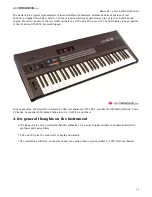
System Setup
Since the use of many basic MIDI functions might depend on the contents of a specific set
of
Voice & Performance data, the DX7s provides a special memory location, System Setup
Memory, to store basic MIDI parameters and orher data in conjunction with a Voice &
Peformance Memory block. This System Setup Memory contains settings
for
the
following parameters:
Transmit Channel
This parameter allows you to set the DX’s MIDI transmit channel. If you turn this
parameter off, no MIDI data will be sent.
Receive Channel
You set the DX’s MIDI receive channel with this parameter. If you turn this parameter off,
all incoming MIDI data will be ignored.
Omni Mode
When Omni mode is on, the DX7s will receive MIDI data from all of the 16 MIDI
channels (the MIDI receive channel is disregarded).
Local On/Off
If Local is set to off, notes played on the DX7s keyboard will not engage the DX’s
internal sound mechanism. Turning Local off has no effect on the transmitted MIDI data.
MIDI IN Control Number
This parameter sets the MIDI controller number for the MIDI Controller (MC) functions
programmed with each voice. The function of this controller is set via button 26 (see page
51).
CS 1 and CS 2 Controller Numbers
The CS 1 and CS 2 Controller Number parameters have two functions:
1. To set the controller numbers that will be transmitted by
CS 1 and CS 2 via the MIDI out. This is useful for controlling external MIDI
instruments.
2. To set the controller numbers that will control the voice parameters assigned to CS
1 and CS 2 in the Performance data. This is useful for changing voice parameters
from an external MIDI device.
- 75 -
Summary of Contents for DX7s
Page 1: ...YAMAHA DIGITAL PROGRAMMABLE ALGORITHM SYNTHESIZER OWNER S MANUAL ...
Page 7: ...Playing the DX7s 1 ...
Page 25: ...Creating and Storing New Sounds 19 ...
Page 34: ... 28 ...
Page 35: ...Using the New Performance Features 29 ...
Page 38: ...Button 29 LCD Displays 32 ...
Page 45: ...Entering the Micro Tuning Edit Mode Editing Micro Tuning Data Storing Micro Tuning Data 39 ...
Page 46: ... 40 ...
Page 47: ...Using the New Voice Features 41 ...
Page 51: ...Button 10 LCD Displays 45 ...
Page 64: ...Editing Fractional Scaling Data Storing Fractional Scaling Data 58 ...
Page 65: ...Memory Functions 59 ...
Page 68: ...Button 14 LCD Displays 62 ...
Page 69: ... 63 ...
Page 76: ...Formatting a RAM Cartridge Loading Voice Performance Data from a RAM Cartridge 70 ...
Page 77: ...MIDI Functions 71 ...
Page 80: ...Button 32 LCD Displays 74 ...
Page 85: ...Appendices 79 ...
Page 89: ......
Page 90: ...MIDI DATA FORMAT 1 Transmission Requirements Add 1 ...












































